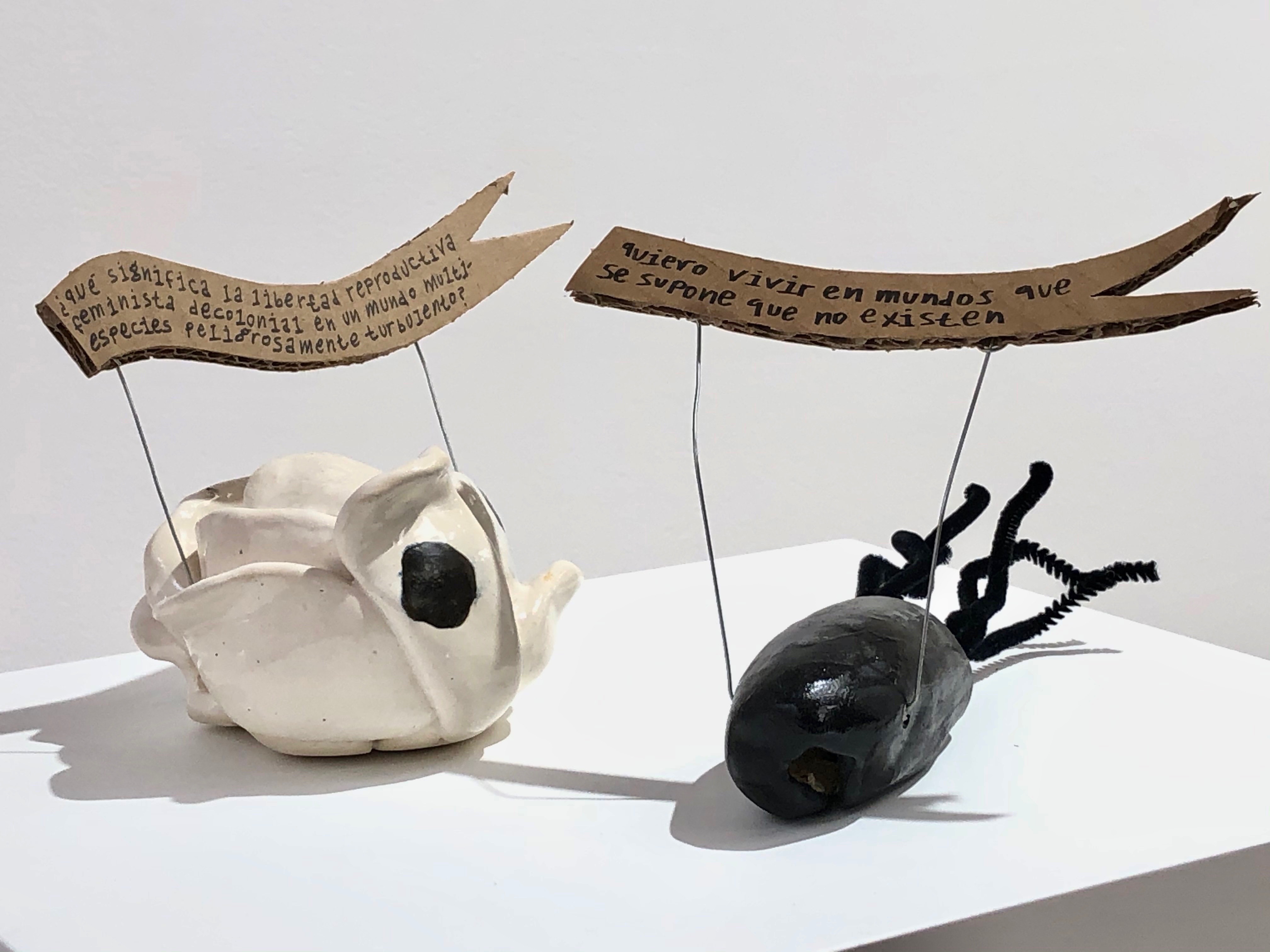
Review
From Books to the Walls and Back: Verónica Gerber Bicecci at Proyectos Monclova
by Sandra Sánchez
Reading time
7 min
Being attentive to what others say, whether they are friendly or tyrannical: taking words and forms as a kind of transit, as materials in movement that are modified symbolically as well as bodily via continuous and discontinuous relationships. Additions and subtractions between form and matter, between subjects-readers-producers. Also invisible to the eye, but present in intuition. The exhibition Descalzos los pies, los campos en ellos, sentiré al acreedor de la tierra en mis plantas desnudas (“Barefoot in the field, I will feel the creditor-earth on my naked soles”), by Verónica Gerber Bicecci at Proyectos Monclova, presents a series of readings and positions that have little to do with the notion of the individual artist, or with its possible antithesis: a given community. What we are shown is a series of ideas and calligrammatic[1] problems that tauten images and texts so that in this interstice the person who is seeing-reading can create a space that also incorporates themselves.
The show welcomes us with a kind of demonstration.
La resistencia (“The Resistance,” 2020) is the name of a series of rather cute ceramic animalcules*2 holding up cardboard banners (phylacteries*3) with precise handwritten messages: “What is decolonial feminist reproductive freedom in a dangerously troubled multispecies world?”; “You’re in trouble if you think the future is a place that belongs to you;” “I want to live in worlds that are not supposed to be;” “Infidelity to patrilines seems the least we should demand of ourselves!”; “We won’t go back to normality because normality was the problem;” “Making—and recognizing—kin is perhaps the hardest and most urgent part.”*4
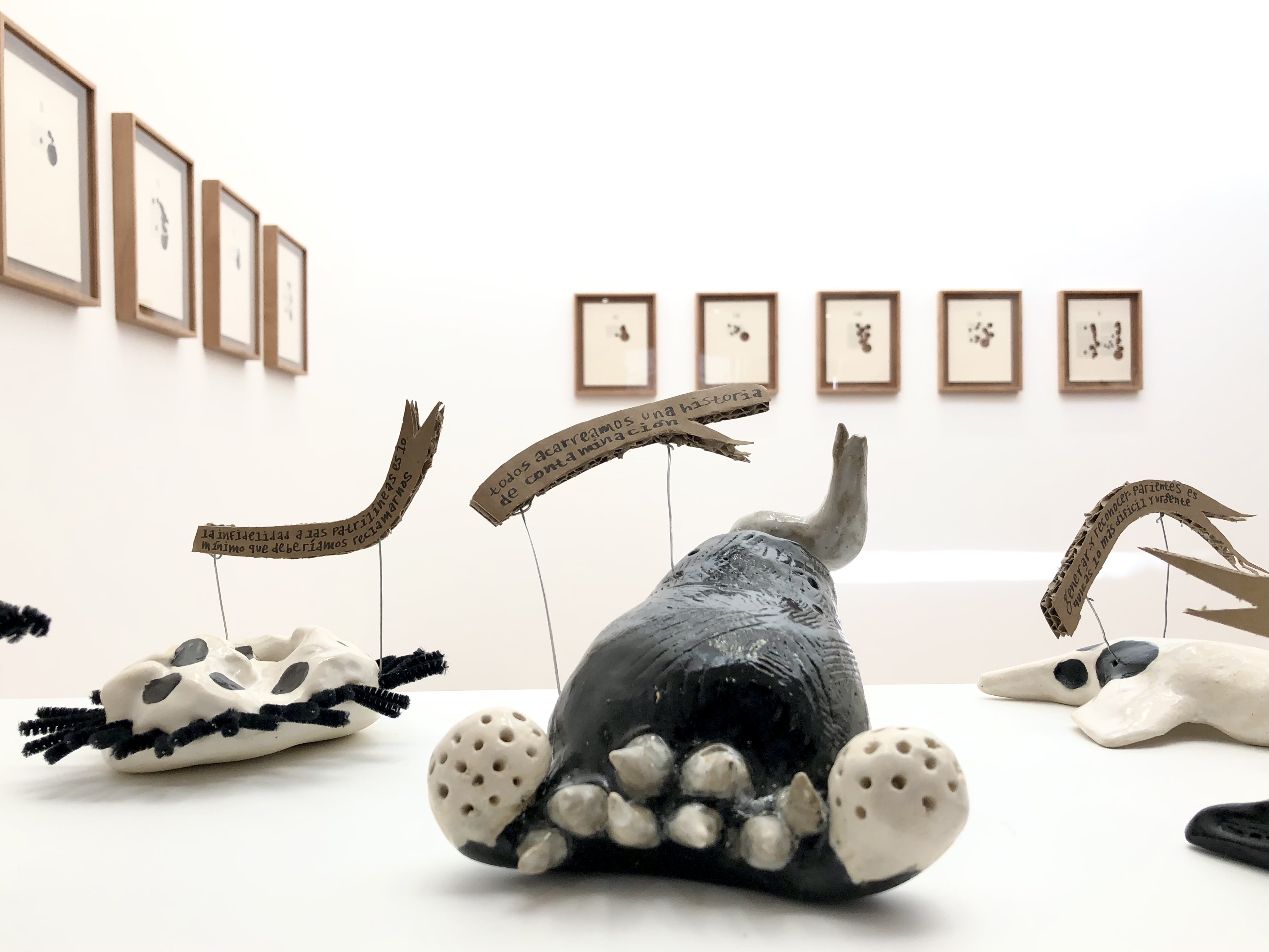
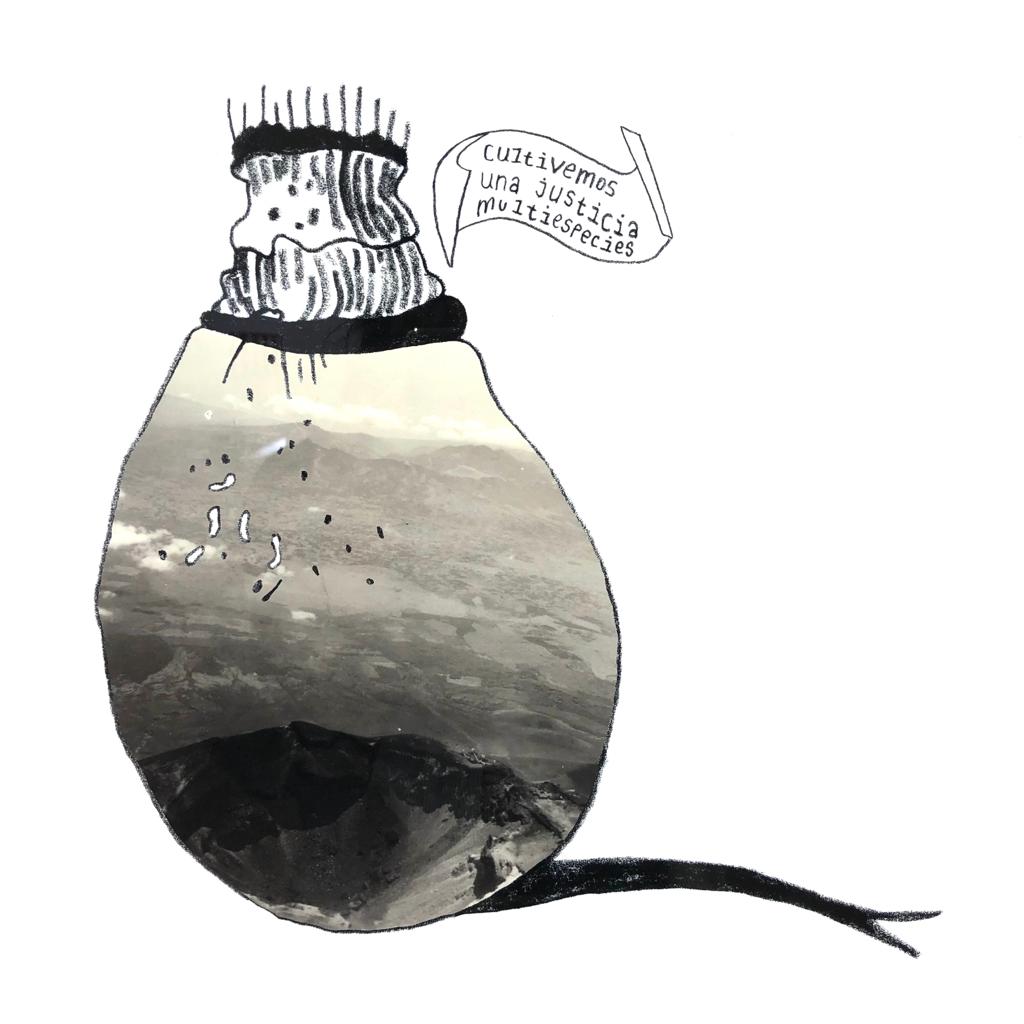
The first impulse is that of possession. These are so cute that I would love to have the budget to buy one and keep it in my house, in order to stare at it each morning. Then I think about whether these words were written in order to face one another. I don’t know how much time has passed, but voices in the gallery awaken me. I think that the question I have most incorporated is that of the need to recognize kin: in my friends, but also in the texts, the works of art, and, of course, the little cat that lives with me. The phrases reverberate so much and so loudly that I would have loved to have had a chair and a coffee nearby in order to rest and continue thinking. Days later, the animalcules are still making noise, and I think they will continue doing so indefinitely.
In the video that Verónica prepared for the gallery’s website, she talks about Mujeres polilla (“Moth Women,” 2018): the artist carried out, in collaboration with Impronta Casa Editora, a movable type print of the Types of Women by Semonides of Amorgos (6th century B.C.), a poem horrible in its misogyny. The intervention by the artist-moth consisted of consecutively boring circles into the paper. These holes gnaw at the poem, just as the moth does with wood. I am fascinated by the idea not of destruction, but of digestion—the image of a moth-woman eating and defecating language. In this waste there’s no revenge or war or arguments winning over other arguments: there’s only compost.
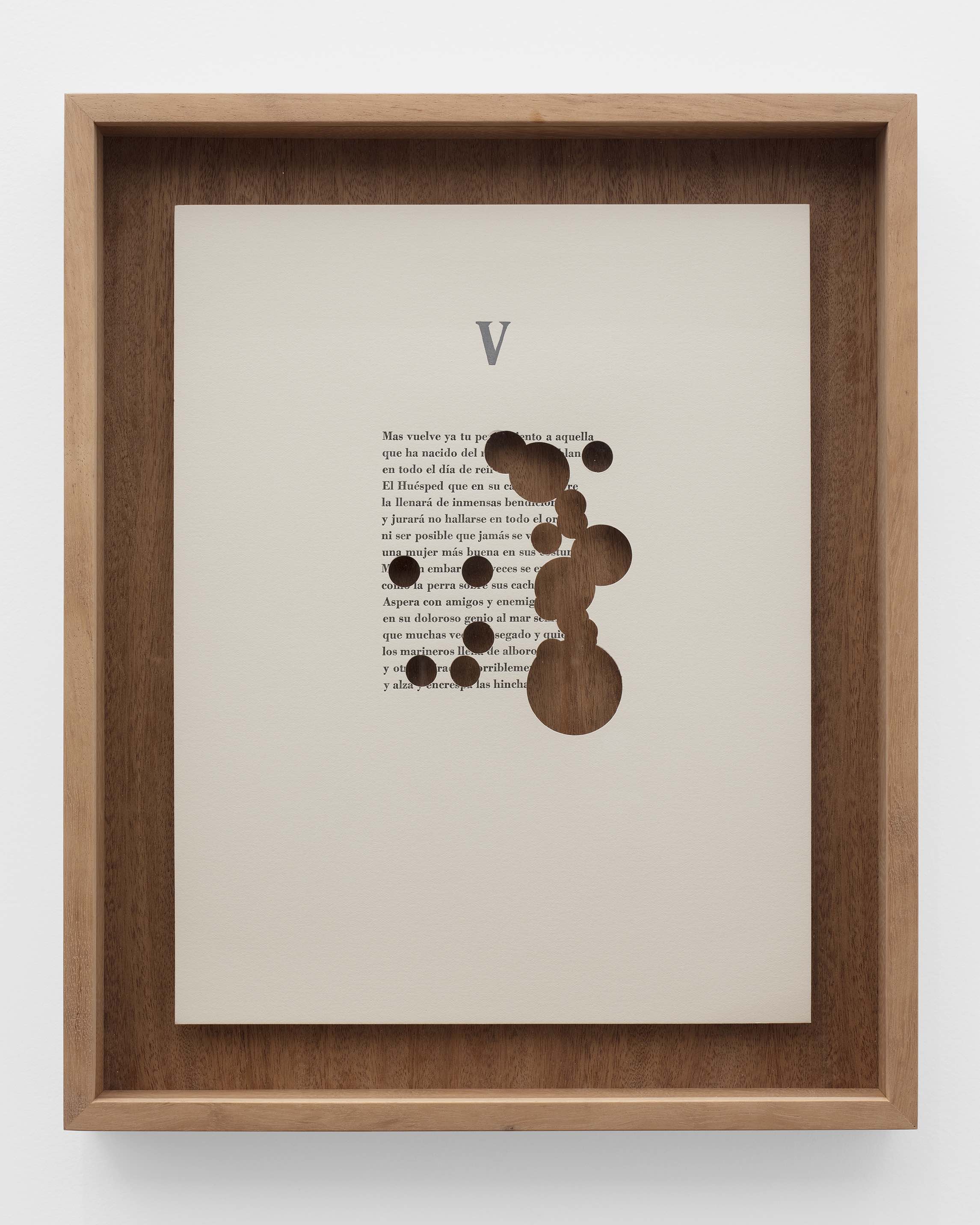
Mujeres polilla also lives as a reproduction in the pages of Tsunami (Sexto Piso, 2018), a compilation of texts by various women who regard the word as a political tool, edited by Gabriela Jauregui. As we will see below, this is not the only piece by Gerber Bicecci that traverses from the gallery to the publishing world and back. I think that this flexibility is the effect of what Caroline A. Jones*5 calls discursively determined forms in art, which she relates to neo-conceptual productions in which forms incorporate specific narratives, opening the way to the concrete as well as the formless and indeterminate. In the case of Gerber Bicecci, the discursively determined forms do not refer to a unidirectional reading, but rather allow for a circulation between media, affecting one another and promoting movements from one space to another, in this case between book and gallery wall.
The tour continues with Otro día... (poemas sintéticos)*6 (“Another day…(synthetic poems),” 2017), in which the calligram again appears, though this time the reference is to Un día... (poemas sintéticos) (“One day…(synthetic poems)”) by José Juan Tablada. Verónica takes up the circular shape of prints, accompanied by verses about nature, in order to reflect on ecological catastrophe. In this instance the sources are journalistic notes concerned with just this problem. It is nice to see the installation in two long rows: all at once there appears an illustrated semantic field. It is fortunate, however, that it also exists as a book, since each haiku demands its own time, and I think that the meaning changes depending on the day and on the viewer-reader’s mood.
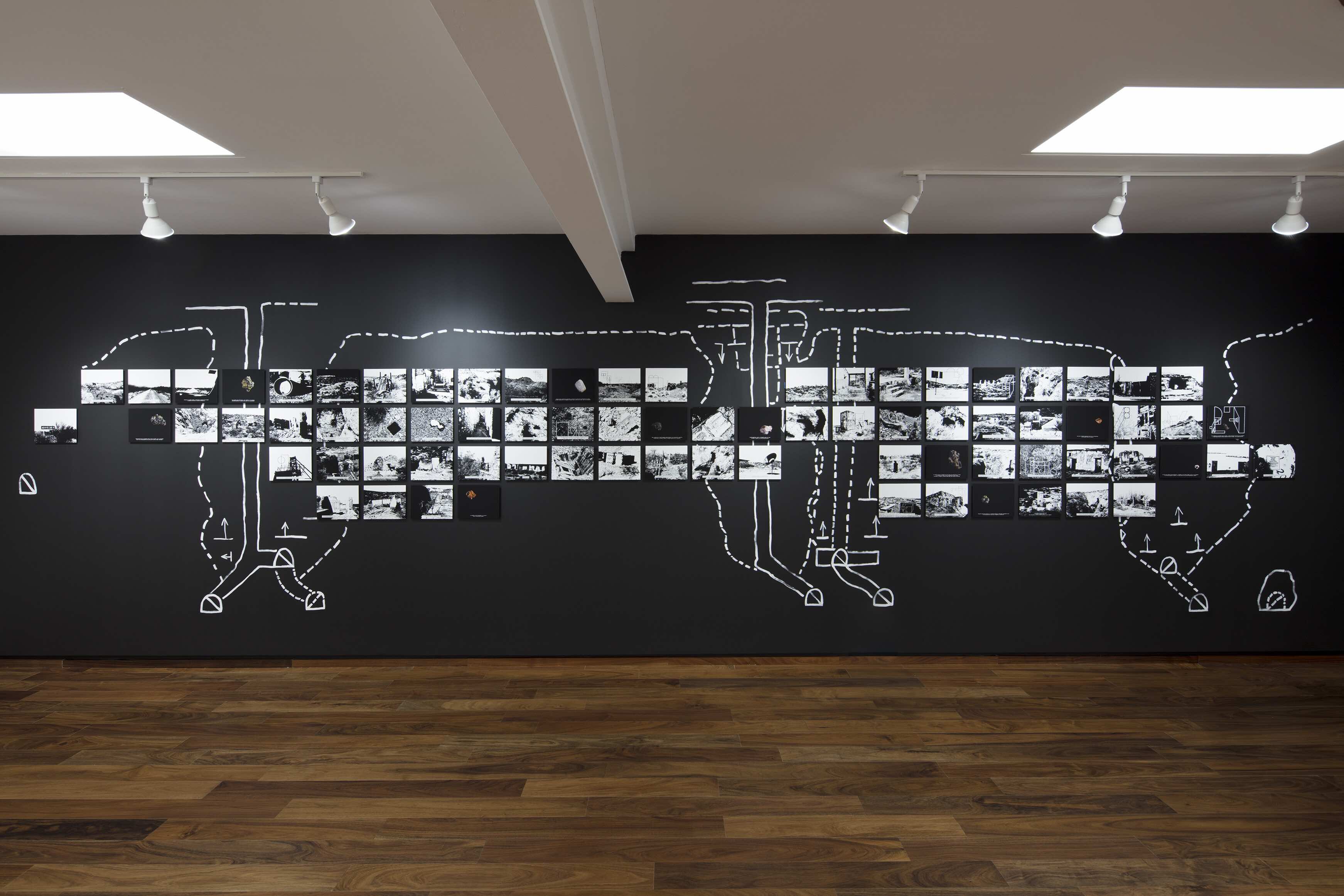
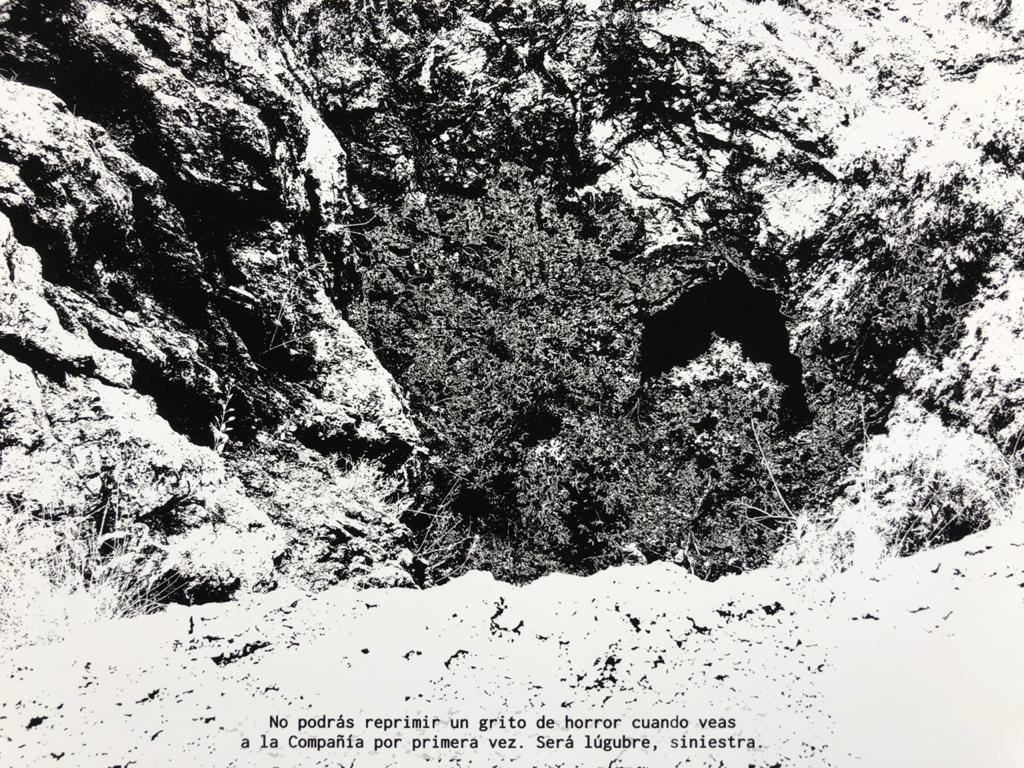
In front of the synthetic poems, under a black background, one finds La compañía (“The Company,” 2018), a piece carried out within the framework of the thirteenth Femsa Biennial, titled Nunca fuimos contemporáneos (“We Have Never Been Contemporary”). The installation consists of a white map drawn on a wall that has at its center 77 photographs of the ruins of a mercury mine in San Felipe Nuevo Mercurio, Zacatecas. Each photograph is accompanied by a text placed in the style of a film subtitle; the story is a rewriting of the narrative “El huésped” (“The Guest") by Amparo Dávila.*7 Reading each photogram requires a bodily movement from left to right, repeated in four rows: the body walks in order to learn out about the terror that this company causes in a woman, her husband’s complete lack of empathy, as well as the woman’s forming an alliance with a machine in order to take care of her children. If one takes distance from it, the cinematic experience disappears, and the mural then appears before one’s eyes: an image-map that hints at a way out.
Up until seeing this piece, what had crossed my mind was the relationship between architectural facades, muralism, and the regular intervals of images on film. I feel that this link is a Gerber Bicecci effect: in this exhibition the media vibrate, the proposals mutate—depending on the complicity they establish with each visitor—and the rewritings are updated, causing the stories to expand.
To visit the exhibition, one should contact Proyectos Monclova.
Online registration can be found here.
Translated to English by Byron Davies.
*1: Verónica Gerber discusses calligrams in a talk available online: Caligrama roto (o de cómo lectoescribir la imagen–texto)
*2: The term animalcule was invented by Anton Van Leeuwenhoek to refer to the small organisms or protozoa that he observed through his microscope in 1674. This information comes from the website of Proyectos Monclova.
*3: The phylactery is a ribbon or small roll of paper used in medieval art to function as a kind of “word bubble.” This information comes from the website of Proyectos Monclova.
*4: These phrases were extracted from two books central to understanding the current environmental crisis: Staying with the Trouble: Making Kin in the Chthulucene, by Donna Haraway, and The Mushroom at the End of the World: On the Possibility of Life in Capitalist Ruins, by Anna Lowenhaupt Tsing. This information comes from the website of Proyectos Monclova.
*5: Jones, Caroline. “Form and formless,” in A Companion to Contemporary Art since 1945, ed. Amelia Jones. UK, Blackwell Publishing, 2006.
*6: This piece also exists in the form of a book published by Almadía.
*7: The printed aspect of this piece was published a year later, likewise by the Almadía publishing house.
Published on February 6 2021